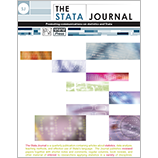Estimation of multinomial logit models with unobserved heterogeneity using maximum simulated likelihood
Peter Haan
DIW Berlin
Königin-Luise-Straße 5
14195 Berlin, Germany
[email protected]
|
Arne Uhlendorff
DIW Berlin
Königin-Luise-Straße 5
14195 Berlin, Germany
[email protected]
|
Abstract. In this paper, we suggest a Stata routine for multinomial logit models with
unobserved heterogeneity using maximum simulated likelihood based on Halton
sequences. The purpose of this paper is twofold. First, we describe the
technical implementation of the estimation routine and discuss its
properties. Further, we compare our estimation routine with the Stata
program gllamm, which solves integration by using Gauss–Hermite
quadrature or adaptive quadrature. For the analysis, we draw on multilevel
data about schooling. Our empirical findings show that the estimation
techniques lead to approximately the same estimation results. The advantage
of simulation over Gauss–Hermite quadrature is a marked reduction in
computational time for integrals with higher dimensions. Adaptive quadrature
leads to more stable results relative to the other integration methods.
However, simulation is more time efficient. We find that maximum simulated
likelihood leads to estimation results with reasonable accuracy in roughly
half the time required when using adaptive quadrature.
View all articles by these authors:
Peter Haan, Arne Uhlendorff
View all articles with these keywords:
multinomial logit model, multinomial logistic model, panel data, unobserved heterogeneity, maximum simulated likelihood, Halton sequences
Download citation: BibTeX RIS
Download citation and abstract: BibTeX RIS
|
